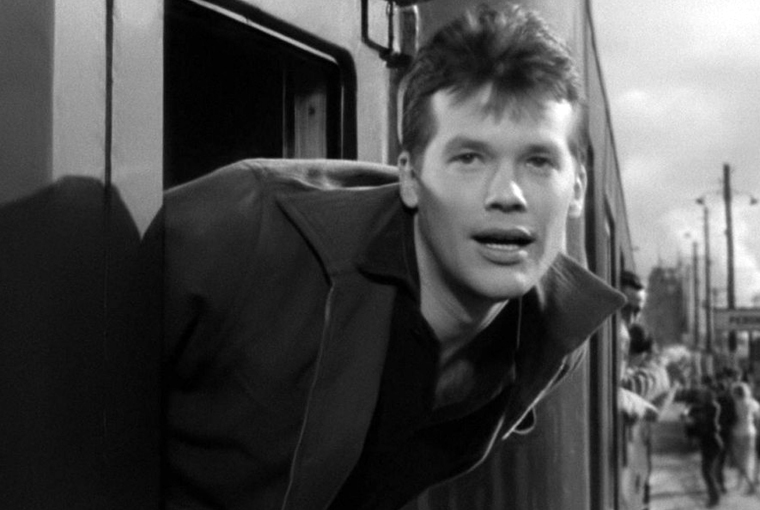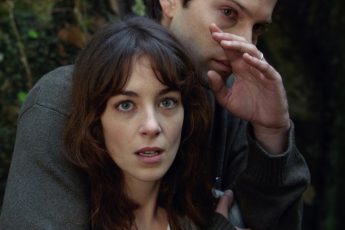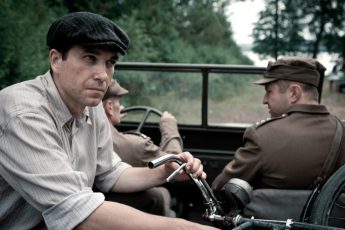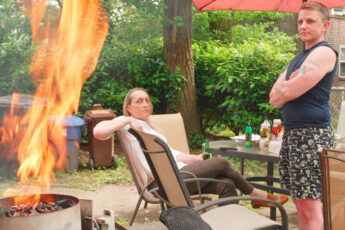The Last Stop
Jerzy Kawalerowicz’s Night Train (Pociag, 1959)
Vol. 40 (April 2014) by A. G. Khandros
Jerzy Kawalerowicz’s Night Train possesses the hallmarks of a classic train film: a killer on the loose, a chance meeting of two attractive travelers forced by circumstance to share an overnight cabin, and a constrained mise-en-scène. Kawalerowicz, however, is up to something else here, and behind flirtation, wisecracks, and suspense lurks a deep emptiness. At the end of the film, many questions of the plot remain unanswered, some of the central relationships unfulfilled, their purpose inscrutable. For a film ostensibly concerned with sexuality, there is a latent sense of loneliness and loss pervading the actions and words of the characters. The film is about a lack at the heart of Polish culture, haunted by its immediate past; Kawalerowicz is still waiting for the train to arrive somewhere new.
The opening credits play over a bird’s-eye view of people ascending and descending a crowded stairwell. The scene invites the viewer to draw patterns out of the flow of incoming and outgoing passengers – people run, bump into each other, stop; some seem to know one another, a group rushes through, another almost concatenates. The shot is flat and obfuscates the depth of the stairwell. And so too, is the viewer’s understanding of the scene – who tried to catch the train? Who just disembarked? Some hurry up, some hurry down, but there is no inherent narrative in the flow of persons, just clusters of electrons being channeled down a two-way circuit. The scene would be wholly anthropological if it weren’t accompanied by a woman’s voice gently scatting a tune over an aimless track of bass and vibraphone. The shot reflects the many stories, the various intertwined narratives, and the glimpses of personalities and egos bumping into one another that will follow; and it foreshadows the moral void that explodes in the film’s climax, which until that point had been masked by abrasions, interactions, and shared utterances of the passengers jostling against each other aboard the train.
The protagonist Jerzy (Leon Niemczyk), a tired-looking man hiding behind sunglasses, hurries to catch a train departing for the coast, darting around lovers saying goodbye and jostling against other onrushing passengers. He tries to buy a last-minute ticket from the conductor as the eclectic variety of characters who will populate the train load around him: a lonely, flirtatious married woman, an elderly priest with his young acolyte, a youthful unmarried couple, the young woman tightly clutching a small radio with her white gloves. As the characters load and bump into each other in the close quarters, the camera performs patient, long pans of the very horizontal setting, examining multiple dialogues and relations in a single shot, and following the gaze of one character as he watches another go by, allowing the audience to take into account the light and ephemeral glances and gestures which take place among the strangers. The cramped and robust mise-en-scène, flitting between the busts of the various passengers, framing their momentary tells of desire, hope and judgment, stands in stark contrast to the cold overhead shot of the beginning. Their forced co-habitation on the train takes on a deeper resonance, and becomes an experiment whose subject is post-war Polish culture. The other main constellation of narrative significance becomes apparent while Jerzy boards, as we hear some characters lingering in the hall chatting about a man running away from the police for murdering his wife; this incidental mention of a newspaper headline will slowly snowball into one driving half of the story. Indeed, in the beginning the film suggests that the anxious protagonist with the loud sunglasses must be the killer, as the other passengers will come to explicitly profess after he is accused (“He was weird, he didn’t look you in the eyes”), and the corollary expectation that this train ride is his attempt to escape. The formal and narrative constraints posed by the setting further point to Night Train’s own boundaries as a film; a story relentlessly develops as the wheels and the reels spin. Over the course of a single ride, people and their relations will come together in a structuring of significance, with the arrival at the final stop signaling an end to both journey and story.
Jerzy buys two tickets to have a compartment by himself – harried, flustered and fraying at the edges, he only desires privacy and rest. However, privacy, at least, is not in the cards, and when he enters his cabin he is distraught to find a young woman, Marta (Lucyna Winnicka, Kawalerowicz’ wife), occupying the lower bunk. After she refuses to leave, Jerzy chooses to avoid a hysterical confrontation, and agrees to share the overnight room with her. Their isolated relationship will be the other main narrative thrust of the film, and their semi-scandalous engagement will be both the main concern of the other passengers, and reflect the effects of the cramped and forced circumstances of all the characters on the train. The camera occupies each character’s vantage as they interact, thrusting the viewer into the process of becoming familiar with another person. Jerzy is bent over as Marta first enters the room; stooped over, the camera from his view is at a low angle, and the frame is filled with her legs on which the camera lingers for quite a moment (as the train whistle blows) before pivoting upwards to catch her reprimanding gaze, staring straight at the camera. The following shot assumes Marta’s view, watching Jerzy awkwardly rushing upright, embarrassed at having ogled her. He bumps his head on the bunk as he stands up straight, once again looking straight at Marta, and the audience. It’s an extremely effective technique that Kawalerowicz frequently employs, forcing the viewer into the role of the characters: their subjectivity, their discomfort and their personal process of manifesting and regulating will and desire. These narrow camera angles and the cramped, claustrophobic framing convey the confined condition of the world on the train and the bodies that inhabit it.
Marta and Jerzy are the main subjects, and the relationship they share is on display not only to the audience, but to the other passengers on the train as well. The other passengers both pass judgment and harbor jealousies; the forced coupling is somewhat scandalous, and all have vague expectations and fantasies about what will go on in that cabin behind closed doors. Jerzy even comments on this public scrutiny, laughing about what they must think; and yet the courtship is anything but the easy seduction that the other passengers are dreaming of. Jerzy is disturbed with himself, in a particular state of anxiety, clumsy and awkward, inexplicably disturbed by the sight of Marta’s legs which she tightly tucked away in her bed sheets; Marta is weepy, lost, lonely, even suicidal, haunted by a lost love and also chased by a volatile former lover (Zbigniew Cybulski). Both Marta and Jerzy are agitated and isolated, and slowly come to realize how much they need each other’s company, conversation, and love to restore each other. They are allowed to be alone, and like the modern unmarried couple, it doesn’t really matter if they are romantic; behind this ease of relations, between these two bodies occupying the same room, lies the primordial terror of the opening shot: the insignificant movement of bodies through space, the failure of a way of life to provide meaning.
Missed relations, suppressed desire, comforting gestures and expressions of loneliness radiate outwards from their cabin and into the rest of the train. The lover chasing Marta sends hopeless love letters, and becomes increasingly violent and self-destructive; the neglected wife serves as Marta’s jealous double and flirts with Jerzy at every possible juncture; romance blooms between the pair of homely, jovial train conductors. On a formalistic level, Kawalerowiz’s constrained camerawork accentuates his characters’ desire for love (and the continual interruption of its fulfillment).
The latent sexuality that runs throughout the film is not, however, its central theme. The film is more deeply concerned with the alienation this new moral order covers up. The new configuration of gender relations, one constant reminder of the culture being put to test by Kawalerowicz, is necessarily a byproduct of the liquidation of the previous pre-war conservative culture and its social norms. The resulting freedom is connected to the horrors of World War II, and the revelation of the previous order’s inadequacy to handle the breakdown of civilization. That is, Kawalerowicz’s train population serves as a sample for Polish society at large. The film is a diagnosis of the longings and shortcomings of a culture that hasn’t fully dealt with the horrors of WWII. Postwar Poland was demographically and geographically determined by the events of the war: before the war, Poland contained a sizable minority population, with over thirty percent of the population comprising of non-poles. After the Germans killed the Jews, the Russians displaced and expelled the Germans and Ukranians, and the borders were radically redefined, annexing a sizable chunk of Germany and losing an even larger region to the Soviet Union, Modern Poland was circumscribed by the events of the mid-20th century. The Communist ideology that subsumed Polish culture was seen by some (including, at least initially, Czeslaw Milosz) as a welcome and overdue dissolution of the vestigial, hypertrophied previous order: Milosz recalls that he “was delighted to see the semi-feudal structure of Poland finally smashed, the universities opened to young workers and peasants, agrarian reform undertaken and the country finally set on the road to industrialization.”1
The film was made at the time of the post-Stalinist thaw in Poland, when artists could produce art that wasn’t party-line jingoism; Night Train is a subtle examination of both the lingering trauma of the war and the fact that Communism hasn’t offered a redemptive or meaningful way of being. Thus the failures of the past social order, and the violent rupture from the ancient regime into post-war modernity, is inseparable from the permissive and unfulfilled sexual and social culture represented by the passengers on the train. One character – an insomniac who bemusedly and distantly observes the fleeting abrasions and relations of the passengers on the train – is himself a wraith bearing past violence: he can’t sit in his cabin because the bunks remind him of Buchenwald, where he spent four years. Not only does the breakdown of the past haunt the present, it quietly informs and infects a new normativity that has failed to adequately address the horror of what preceded it. At one point, Marta says to Jerzy, looking at him longingly, “nobody wants to love yet everyone wants to be loved.” Loneliness is hastily covered over with easy sex, as in the case of the flirtatious wife; similarly, a deeper crisis of meaning is tainted by the events of the early 20th century, only halfway remedied by current social norms.
Eventually, the terror of loneliness and anonymity, the progression of Marta and Jerzy’s relationship, and the quiet side narrative of the murderer on the run all fuse into the film’s climax – and the terror lurking behind the actions and relations of the film until this point are uncovered for what they were all along. In the middle of the night, the police board the train, and Jerzy is accused of being the murderer, which the audience has been primed to expect from the beginning. Marta realizes, however, that she bought her ticket from a man who was supposed to occupy their cabin but instead seems to be hiding in the coach class. A chase begins, albeit a restrained one. The cramped hunter and hunted are forced to walk down the narrow halls stuffed with people, barging in on various cabins-cum-microcosms (a group of women on pilgrimage, joyous young women on vacation, a group of exhausted working class men and women). The camera travels with the chase, and as the police encounter more and more passengers, a posse accrues. The accused murderer stops the train, and jumps out into the open farmland, swathed in a pre-dawn fog, with most of the male passengers engaging in a hot pursuit, bonded for the first time with a non-arbitrary sense of justice. At first, it seems as though everyone’s actions have a clear purpose. As they chase the man through the fields, they gain on him while a dog loudly and incessantly barks in the background, suggesting the animal instinct that comes out of a group that has perhaps become blinded with its purpose. But when the murderer is surrounded in a rural graveyard, he becomes an object of pity as the passengers on the train swarm and severely beat him. The camera angle switches from the subjective framing of each individual’s face to the objective bird’s-eye view from the opening sequence; through a cold and accusing lens, the mob swallows the murderer like ants on a morsel of meat. Then, terrified at what they have allowed themselves to become, the crowd retreats, while one man continues to strike the limp body, screaming at him for having broken the moral code – “you want to kill us, do you?” His pathetic kicking is rendered only hollower as the priest reaffixes a knocked-down cross into a grave, a laughable attempt to restore the “normal” order after it has completely evaporated into a barbaric sense of justice.
“Just like children” remarks the insomniac to the priest as they load back on to the train, gesturing toward the lack of any discernible, mature culture shared by the passengers on the train. The terror of the murderer morphs into the terror of the reciprocal violent mob; this fear lingers after the passengers re-board the train, all stricken with panic as they hear the imitated voice of the murderer again, a fear of themselves borne of shame at their own moral failure. The fear evinced by the characters in reaction to the horrible violence committed by another passenger in their midst could perhaps be directly mapped onto the social reality of postwar Poland: the murderer encapsulates the utter horror and breakdown of the Second World War, while the ad hoc mob created to mete out justice could be the Soviet Union, whose justification for the administering of Poland was oftentimes tied to the role they played at defeating and punishing the Nazis – one social order uses the deleteriousness of the previous one to justify more violence, and the past remains to be dealt with. However, the analogy cuts deeper. There is a deep humanist cry for an ideal culture and sense of meaning that acknowledges and confronts the horror of the past and the arbitrariness of any totalizing moral code (be it Nazism, Soviet communism, or [as explored in Kawalerowicz’ next film Mother Joan of the Angels (1961)] Catholicism, or any other dogma) more generally. Jan Józef Szczepanski, a Polish writer who was member of the resistance during the war and never collaborated with the Communists, wrote eloquently about this crisis of meaning for a culture that yearns for a binding normative structure to be able to justly and fluidly navigate reality, yet has just been shown the arbitrariness of its past laws and traditions:
A panicked fear of becoming aware of the true proportions of things makes us seek shelter in sober practicality and in the entrenchments of all kinds of orthodoxies. However this leads inevitably to the trivialization of our existence…. Orthodoxies are crumbling with growing rapidity these days — religious as well as ideological ones — and a man feels more and more defenseless against the pressure of outer darkness […]. A world functioning […] without reason or purpose is an unnecessary world, and so a trivial one. If we are conscious of this, it is also a tragic world.2
After they re-embark, the characters quickly settle back into their roles. For Jerzy, Marta was a patient who had died in surgery that day coming back to life; for Marta, Jerzy was a new chance at love and a life renewed. But right before the train reaches the station, Jerzy reveals that he is married and that his wife is waiting for him at the station. Perhaps the only chance for a new kind of hope was with this new couple. The narrative that the film developed thus slips away, with the two main characters ending their trip as strangers to themselves and to the viewer: Marta shares a look with the murderer right before he is taken away, which suggests some degree of complicity as both break into tears. Whether he was one of her former lovers, or whether they just spontaneously sympathize with one another, it doesn’t matter—the characters lose the significance they had throughout the film. This occurs explicitly with Jerzy, whom everyone on the train considered to be the killer; the insomniac tells him what a pity it was that he wasn’t the one to capture the murderer and become a hero. But neither the main character nor the passengers are granted this transference from victim to hero. Some things change (the insomniac falls asleep, the young lover stops pursuing Marta) and some cycles continue (the neglected woman finds a lover, Jerzy returns to his wife). When Marta walks out of the train, not toward the town but toward the beach, we don’t know if she is full of despair and headed towards her death or in search of renewal and redemption. We watch her walk away through the train window, as she slips off the screen back, out of the structuring of significance, into the obscurity of the opening scene.
After the breakdown of normalcy in the chase of the victim, Kawalerowicz’s question that has been lurking in the utterances, actions and relations that have populated the film becomes explicit: how can the lack of constraints on what one could do become the knowledge of what one should do? On the train we see a lack of a binding, human sensibility covering over a deep dissatisfaction with love and society; so how should everyone act, how can they trust each other, what would this new culture look like? Kawalerowicz doesn’t really prescribe as much as diagnose. As an assistant director, he cut his teeth on the Holocaust and its effects on Polish culture, working on Wanda Jakubowska’s The Last Stage (1948), which was shot on location at Auschwitz, with many of the actors and extras being survivors from the camp. When asked about working with those actors and actresses, Kawalerowicz said they “were wiser than all assistant directors; they knew everything from experience. They saw it. Those former inmates were returning to their places.”3 The Real End of the Great War (1957), the film he made immediately before Night Train, is about a POW assumed dead returning home after the war, physically weak and emotionally shattered, unable to regain his old life or recover from his past trauma.4 Night Train is a more subtle return to the same question: how do we deal with what came out in the past, an emptiness that still lingers in the present? Perhaps the only solution is offered by the unmarried couple with the radio from the opening scene; they are the last characters we see, waking up startled with the realization that everyone else has already disembarked. Their inoculation against the pain of the night has a combination of love (perhaps facilitated by the modern easing of restraints on how two people can be together) and forgetfulness. They likely had the best time of any of the passengers, anyhow—but of course, it was the least worth mentioning.




Great analysis, thank you for the authour.